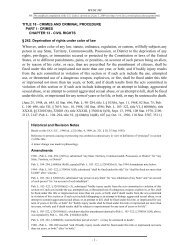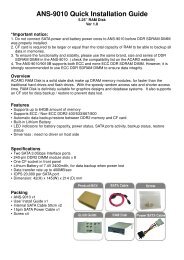2004 Instructions for Form 1040 (ALL) - Supreme Law Firm
2004 Instructions for Form 1040 (ALL) - Supreme Law Firm
2004 Instructions for Form 1040 (ALL) - Supreme Law Firm
You also want an ePaper? Increase the reach of your titles
YUMPU automatically turns print PDFs into web optimized ePapers that Google loves.
Department of the Treasury<br />
Internal Revenue Service<br />
<strong>2004</strong> <strong>Instructions</strong> <strong>for</strong> Schedule D<br />
Capital Gains<br />
<strong>for</strong>m or schedule.<br />
and Losses<br />
Use Schedule D (<strong>Form</strong> <strong>1040</strong>) to report the following.<br />
• The sale or exchange of a capital asset (defined on this page) not reported on another<br />
• Gains from involuntary conversions (other than from casualty or theft) of capital assets<br />
not held <strong>for</strong> business or profit.<br />
• Capital gain distributions not reported directly on <strong>Form</strong> <strong>1040</strong>, line 13.<br />
• Nonbusiness bad debts.<br />
Additional in<strong>for</strong>mation. See Pub. 544 and Pub. 550 <strong>for</strong> more details. For a comprehensive<br />
filled-in example of Schedule D, see Pub. 550.<br />
Section references are to the Internal Revenue Code unless otherwise noted.<br />
4. Ordinary loss on the sale, exchange, (a) or (b), in a way (such as by gift) that<br />
or worthlessness of small business invest- entitled you to the basis of the previous<br />
General <strong>Instructions</strong><br />
ment company (section 1242) stock. owner.<br />
What’s New 5. Ordinary loss on the sale, exchange, • U.S. Government publications, in-<br />
Tax computation using maximum capital or worthlessness of small business (section cluding the Congressional Record, that you<br />
gains rates. You will now use the Qualiby<br />
purchase at the normal sales price, or<br />
1244) stock. received from the government, other than<br />
fied Dividends and Capital Gain Tax 6. Ordinary gain or loss on securities<br />
Worksheet on page 34 of the <strong>Instructions</strong> held in connection with your trading busi- that you got from someone who had re-<br />
<strong>for</strong> <strong>Form</strong> <strong>1040</strong> to figure your tax if you ness, if you previously made a ceived it in a similar way, if your basis is<br />
have net capital gain or qualified dividends. mark-to-market election. See Traders in determined by reference to the previous<br />
However, if you have any 25% rate gain Securities on page D-3.<br />
owner’s basis.<br />
(unrecaptured section 1250 gain) or 28%<br />
• Certain commodities derivative finanrate<br />
gain, you will still use the Schedule D Use <strong>Form</strong> 4684 to report involuntary cial instruments held by a dealer. See sec-<br />
Tax Worksheet on page D-9 to figure your conversions of property due to casualty or tion 1221(a)(6).<br />
tax. Part IV of Schedule D has been elimiinto<br />
in the normal course of your trade or<br />
theft.<br />
• Certain hedging transactions entered<br />
nated.<br />
Use <strong>Form</strong> 6781 to report gains and<br />
losses from section 1256 contracts and business. See section 1221(a)(7).<br />
Capital Loss Carryover Worksheet. Use straddles.<br />
• Supplies regularly used in your trade<br />
the Capital Loss Carryover Worksheet on Use <strong>Form</strong> 8824 to report like-kind expage<br />
D-6 to figure your capital loss carry- changes. A like-kind exchange occurs<br />
or business.<br />
over from 2003 to <strong>2004</strong>. You will need a when you exchange business or investment Short Term or Long Term<br />
copy of your 2003 <strong>Form</strong> <strong>1040</strong> and Sched- property <strong>for</strong> property of a like kind. Separate your capital gains and losses acule<br />
D.<br />
cording to how long you held or owned the<br />
Capital Asset<br />
property. The holding period <strong>for</strong> short-term<br />
Gain on home acquired in a like-kind ex-<br />
Most property you own and use <strong>for</strong> perchange.<br />
If you sold or exchanged your sonal purposes, pleasure, or investment is a The holding period <strong>for</strong> long-term capital<br />
capital gains and losses is 1 year or less.<br />
main home that you acquired in a like-kind capital asset. For example, your house, furexchange,<br />
you may not be able to exclude niture, car, stocks, and bonds are capital as-<br />
figure the holding period, begin counting<br />
gains and losses is more than 1 year. To<br />
any of the gain. See Sale of Your Home on sets. A capital asset is any property held by on the day after you received the property<br />
page D-2 <strong>for</strong> details.<br />
you except the following.<br />
and include the day you disposed of it.<br />
• Stock in trade or other property in- If you disposed of property that you ac-<br />
Other <strong>Form</strong>s You May Have cluded in inventory or held mainly <strong>for</strong> sale quired by inheritance, report the disposition<br />
To File<br />
to customers.<br />
as a long-term gain or loss, regardless of<br />
• Accounts or notes receivable <strong>for</strong> serv- how long you held the property.<br />
Use <strong>Form</strong> 4797 to report the following.<br />
ices per<strong>for</strong>med in the ordinary course of A nonbusiness bad debt must be treated<br />
1. The sale or exchange of: your trade or business or as an employee, or as a short-term capital loss. See Pub. 550<br />
a. Property used in a trade or business; from the sale of stock in trade or other <strong>for</strong> what qualifies as a nonbusiness bad<br />
property held mainly <strong>for</strong> sale to customers.<br />
b. Depreciable and amortizable propdebt<br />
and how to enter it on Schedule D.<br />
erty;<br />
• Depreciable property used in your<br />
trade or business, even if it is fully deprecic.<br />
Oil, gas, geothermal, or other mineral ated. These distributions are paid by a mutual<br />
Capital Gain Distributions<br />
property; and<br />
• Real estate used in your trade or busid.<br />
Section 126 property. ness.<br />
pany) or real estate investment trust from<br />
fund (or other regulated investment com-<br />
2. The involuntary conversion (other • Copyrights, literary, musical, or artistributions<br />
of net realized short-term capital<br />
its net realized long-term capital gains. Disthan<br />
from casualty or theft) of property tic compositions, letters or memoranda, or<br />
used in a trade or business and capital as- similar property: (a) created by your perstead,<br />
they are included on <strong>Form</strong> 1099-DIV<br />
gains are not treated as capital gains. In-<br />
sets held <strong>for</strong> business or profit.<br />
sonal ef<strong>for</strong>ts; (b) prepared or produced <strong>for</strong><br />
3. The disposition of noncapital assets you (in the case of letters, memoranda, or as ordinary dividends.<br />
other than inventory or property held pri- similar property); or (c) that you received Enter on line 13 the total capital gain<br />
marily <strong>for</strong> sale to customers in the ordinary from someone who created them or <strong>for</strong> distributions paid to you during the year,<br />
course of your trade or business. whom they were created, as mentioned in regardless of how long you held your in-<br />
D-1<br />
Cat. No. 24331I













